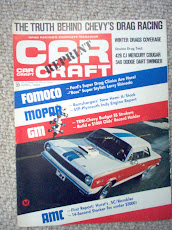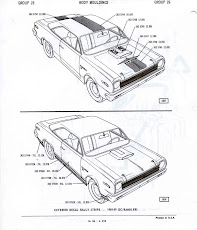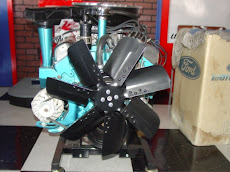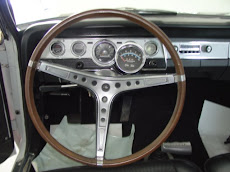Contrary
to what you may have heard, SC/Ramblers are complicated to clone successfully
for several reasons. AMC made 73,356 Americans in 1969. Of that number they
only made 5,055 Rogues in 1969, and of that number 1512 were SC/Ramblers. That
leaves just 3,543 Rogues and only 608 of them had 290 V-8s.* 1966, 67, and 68 Rogues have differences in
the body that hardcore SC/Rambler guys pick up on easily. The grille and the taillights
are different in 1966, and the molding between the roof to the quarter panel was
very different in 1966. Only 1969s had cable accelerator linkage. I personally wouldn’t
want to undertake cloning a SC/Rambler with anything other than a 1969 V-8
Rogue. For all 1969 Americans and some few 1968s made late in the production
run the front frame rails were extended to the start of the rear seat footwell
to strengthen the unibody to resist the torque from V-8s. The catch is there
are still only 608 V-8 Rogues in 1969 except for SC/Ramblers. SC/Ramblers share
rear differential, both cross members, and the battery is on the passenger side
in V-8 Rogues. Most of the 6-cylinder cars share none of these items, because
they were mostly automatics with drum brakes, 6-cylinder rear differential,
standard bench seats, had trim strips from the front reflector to the rear
reflector, and the battery is on the drivers side. Rear seats are common only
between Rogues and the front seat in SC/Ramblers is a 60/40 split bench. Standard
SC/Rambler interior trim was Charcoal 941-D which is not a common option in
Americans or Rogues. Charcoal seat covers are available from Legendary Auto
Interiors and I have heard they have door panels. There are still no
reproduction chrome Rogue trim pieces for the door panels available. I have still
not begun to focus on the many SC/Rambler only parts on just 1512 cars built in
1969. Without having these SC/Rambler only parts, of which a
limited number have been reproduced, it is very difficult to find enough parts
to clone a SC/Rambler starting with a Rogue body let alone expensive.
What
is more common than clones is where someone has a real SC/Rambler that is too
rusted or hard crashed to fix and they try to find a 1969 Rogue to transfer the
parts to and re-body their SC/Rambler. Keep in mind the small number of 1969
V-8 Rogues and consider how many of those are actually a suitable recipient for
SC/Rambler pieces after all these years. Torque links have a nut plate welded
in the inside of the rear frame rails, before the SC/Rambler body was built.
There is the added piece on the radiator core support to hold the passenger’s
side hood pin and the driver’s side rear shock is mounted behind the
differential. Only SC/Ramblers have exhaust pipe hangers on the passenger side
of the car. All SC/Ramblers were painted Bright White. No other Americans were
painted this color. All other AMC cars are some other color under all the
undercoating. Yes, all this stuff can be retrofitted to a 1969 Rogue body, but
it is a big undertaking and at a considerable cost. The restoration costs after
the required SC/Rambler body modifications are performed
remain the same for both cars. After all this, it is still profitable to be
able to sell a clone or re-bodied SC/Rambler from a complete number 5
SC/Rambler parts car for $30,000 or more instead of for $10,000 as a Rogue.
What I have covered here is not the whole story on re-bodying SC/Ramblers. It
is hard to do what I have identified well enough without hardcore SC/Rambler
guys smelling something foul. Thankfully, there remain several lesser known
ways clones or rebodied SC/Ramblers can be easily be identified.
I
know repairing wrecked SC/Ramblers is another aspect of the overall picture,
but it is better to have wrinkled panels somewhere. More serious repairs such
as front or back-halved cars need to have complete documentation on the wreck
repair. Most SC/Ramblers have battery drool on the inner fender panel on the
passenger side of the car where the battery tray is. Replacing this panel is
not enough to condemn a SC/Rambler. If there are no usual telltale signs of
collision repair, then with documentation the car has a much greater
possibility of being an excellent unblemished SC/Rambler example.
A
common problem with AMC cars is the factory kept NO record of how their cars
were made. A numbers matching SC/Rambler or any AMC car is an illusion. On
SC/Ramblers, I guess this means the trunk lid, the transmission, and the dash
pad were made about 3 to 8 weeks before the car was made, maybe. Consequently
and particularly SC/Ramblers have a few production line deviations that prevent
making 100% positive statements about how all SC/Ramblers were made. However,
this does not provide an open invitation for all the things uninformed people
claim came on their eight owner SC/Rambler from the factory. The only way a
small group of hardcore SC/Rambler guys can understand what might have happened
is to match certain assembly irregularities with when these cars were most
likely produced. Weird stuff, like my
original SC/Rambler
has a very high serial number, actually door tag E number, had no SC/Hurst
emblem on the rear of the car and one tail light housing is blasted chrome
sprayed flat black. This is instead of the yellow chromate coating before being
painted like almost all SC/Rambler taillights. Several of us think, at the end
of SC/Rambler production AMC ran out of these items and thought the dealer
might catch these things and fix them or not. For general information, the VIN
has no relationship to when an AMC car was made. The production number on the
bottom of the door tag is the E number on Americans and it is the only way to
find out when any SC/Rambler was likely made. The E stands for the east
assembly line at the Lakefront assembly plant in Kenosha. AMXs, Javelins, and
Americans were made on this line. Also please note, no information exists as to
when any 1968 cars were made at all. -Jim
McKee
*
1969 AMC production numbers provided by Tom Benvie.









No comments:
Post a Comment